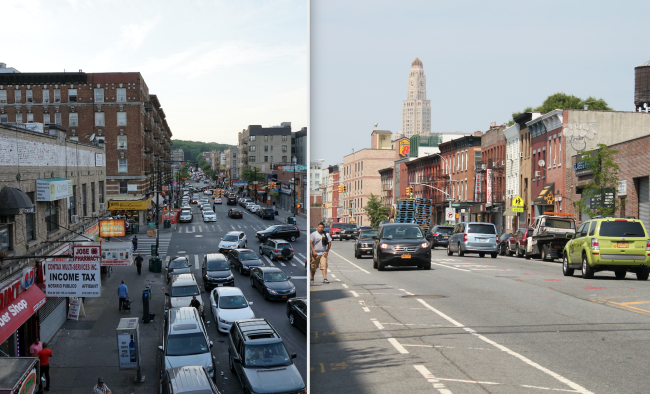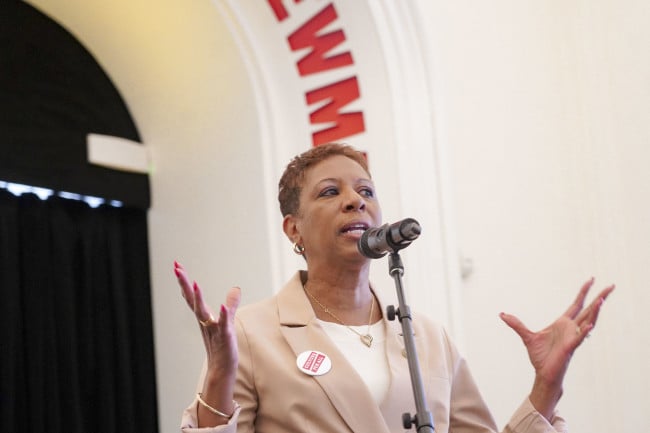With the help of $5 billion, City of Yes passes key committee vote
- The citywide-rezoning plan will get $4 billion from the city and $1 billion from the state
- The plan was modified to reflect parking concerns; it goes to a full Council vote Dec. 5th

Speaker Adrienne E. Adams and City Council members took the opportunity to make changes that increase affordability and satisfy concerns in their districts.
John McCarten/NYC Council Media Unit
A modified version of Mayor Eric Adams’s citywide-rezoning plan passed a crucial City Council committee vote last night after gaining significant investments of $4 billion from the city and $1 billion from the state for infrastructure and affordable housing sought by the Council.
The proposal, City of Yes for Housing Opportunity, aims to add 80,000 additional units of housing over 15 years (a previous iteration of the plan set a goal of generating up to 109,000 units) to ease NYC’s housing crisis by reducing barriers to building denser housing.
The mayor’s ambitious plan has drawn considerable attention and input from all 59 community boards, the committee on land use, and a grueling 14.5 hour public hearing with 300 testimonies. With Adams’s political clout dimmed by his indictment on federal corruption and bribery charges, Speaker Adrienne E. Adams and City Council members took the opportunity to make changes that increase affordability and satisfy concerns in their districts in exchange for their support.
Hours of negotiation delayed the vote; it was passed shortly after 6 p.m. by the City Council’s land use and zoning subcommittees. A full Council vote is set for Dec. 5th.
Partial victory on parking
Core components of the plan remain intact with some modifications to address concerns from Council members who represent neighborhoods where housing is mostly one- and two-family properties and cars are the dominant form of transportation.
The key sticking points of the original proposal was the removal of parking mandates citywide for new housing. The modified plan would create three geographic zones for parking requirements. There are no parking mandates for Zone 1, which includes Manhattan (except Inwood), Long Island City, parts of Western Queens and Brooklyn; and reduced parking requirements in Zone 2. Parking mandates would be maintained for Zone 3, which are areas where residents depend on cars to get around.
That was a blow to groups seeking to reduce dependency on cars in the outer boroughs.
"While cities across the country are fully lifting parking mandates, the New York City Council chose to be less bold,” said Sara Lind, co-executive director at Open Plans, which describes itself as a “people-first street culture” advocacy group.
“We’re disappointed that it has once again proven so difficult for our leaders to stand boldly against car dominance, even as some Council members bemoan their districts’ lack of safe streets and transit options,” Lind said.
Adieu basement ADUs
The initial plan called for allowing accessory dwelling units or ADUs to be built to increase housing, but concerns about flooding prompted the City Council to prohibit ground-floor and basement ADUs in flood-prone areas, as well as several types of backyard ADUs.
Exemptions for single-family zoning
The City Council also added incentives for building affordable housing near transit and commercial areas and excluded single-family zoned areas from areas considered transit districts, where City of Yes would allow new three- to five-story apartment buildings.
Brooklyn Borough President Antonio Reynoso disagreed with the decision to exempt R1-2A, R2A, and R3A contextual districts.
“There will be effectively no new housing options for people to live in these communities— which means these neighborhoods remain exclusive and the legacies of segregation and exclusionary zoning live on unfettered,” Reynoso said. In addition, it puts pressure on other neighborhoods to add more housing.
“City of Yes was never going to fix everything …but it was at least a modest opportunity to begin addressing the discriminatory zoning practices that force low-income, Black and Brown neighborhoods to do all of the work of building new housing while low-density neighborhoods get away with contributing nothing,” he added.
Deeper affordability
The new version of the plan adds a deep affordability requirement to a zoning incentive in high-density districts, with developers setting aside 20 percent of units to be affordable for families earning 40 percent of the Area Median Income, targeting incomes between $40,000 and $70,000, a shift from 60 percent AMI.
Community groups have been concerned that City of Yes would allow projects to grow much higher than permitted by zoning. The new version of the plan adds a special permit for height increases greater than 25 percent.
Housing for All meets City of Yes
Speaker Adams had pushed for greater investment alongside zoning reforms with the introduction of “City for All,” an affordable housing initiative described as the City Council's response to City of Yes.
“We must go beyond zoning reforms to address all the unrelenting housing pressures that leave New Yorkers struggling to afford finding or staying in homes,” Speaker Adams said in a previous statement.
Still, zoning changes are critical to affordable housing development in NYC, Rachel Fee, executive director of New York Housing Conference, told Brick previously. She said that City of Yes, along with investment, will “pair well with the tax incentives passed in Albany in the spring,” which include a new version of 421-a tax break for developers as part of the state budget.
You Might Also Like



























